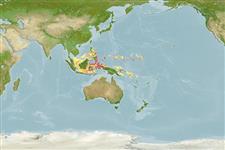>
Gobiiformes (Gobies) >
Gobiidae (Gobies) > Gobiinae
Etymology: Eviota: No etymology given, suggested by Christopher Scharpt: from Latin 'eu' for 'true' and 'iota' for anything very small, in combination 'truly very small' referring to it as being the smallest vertebrate at the time it has benn described by Jenkins (thus, making the suggestion by Scharpt plausible.; pinocchioi: Named after Carlo Collodi’s fictional character Pinocchio; referring to the exceptionally long anterior tubular nares in this species..
Environment: milieu / climate zone / depth range / distribution range
Écologie
marin récifal; profondeur 14 - 73 m (Ref. 92345). Tropical
Western Pacific: Palau and Indonesia.
Taille / Poids / Âge
Maturity: Lm ? range ? - ? cm
Max length : 1.7 cm SL mâle / non sexé; (Ref. 92345)
Description synthétique
Clés d'identification | Morphologie | Morphométrie
Épines dorsales (Total) : 7; Rayons mous dorsaux (Total) : 9; Épines anales: 1; Rayons mous anaux: 8; Vertèbres: 25. This species is distinguished from its congeners by the following set of characters: cephalic sensory-pore system always lacking POP and IT pores, PITO and AITO pores fused 50% of time; dorsal/anal fin-ray formula 8/8; unbranched pectoral-fin rays; 4th pelvic-fin ray bifurcated with each branch about 50% of the total length of the ray; unbranched 5th pelvic-fin ray 6.5-15.3 (11.0%) of 4th; in males, dorsal-fin spines are filamentous, very long tubular anterior nares, length almost equal to pupil diameter, reaching well anterior to the upper lip, and black; in life body translucent and crossed by six narrow red bands and when preserved, devoid of obvious dark marks on body (Ref. 92345).
Found in vertical drop-off with caves and sandy and slope with some Halimeda (Ref. 92345).
Life cycle and mating behavior
Maturities | Reproduction | Spawnings | Egg(s) | Fecundities | Larves
Greenfield, D.W. and R. Winterbottom, 2012. Two new dwarfgobies from the Southwestern Pacific Ocean (Teleostei: Gobiidae: Eviota). Zootaxa 3572:33-42. (Ref. 92345)
Statut dans la liste rouge de l'IUCN (Ref. 130435)
Menace pour l'homme
Harmless
Utilisations par l'homme
Outils
Articles particuliers
Télécharger en XML
Sources Internet
Estimates based on models
Preferred temperature (Ref.
123201): 27.2 - 29, mean 28.7 °C (based on 20 cells).
Phylogenetic diversity index (Ref.
82804): PD
50 = 0.5000 [Uniqueness, from 0.5 = low to 2.0 = high].
Bayesian length-weight: a=0.01023 (0.00477 - 0.02194), b=3.02 (2.84 - 3.20), in cm total length, based on LWR estimates for this (Sub)family-body shape (Ref.
93245).
Niveau trophique (Ref.
69278): 3.0 ±0.3 se; based on size and trophs of closest relatives
Fishing Vulnerability (Ref.
59153): Low vulnerability (10 of 100).
